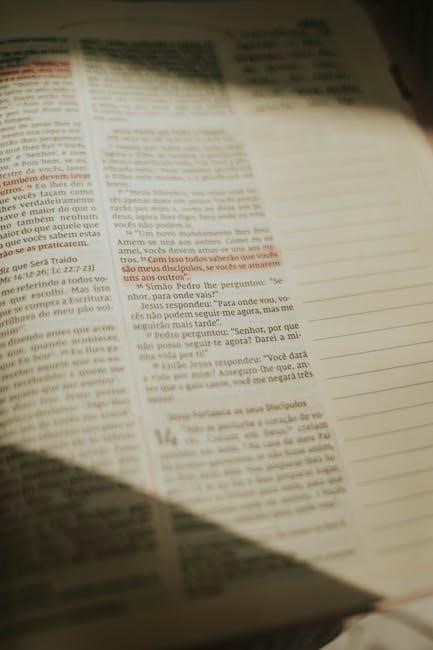A reference letter is a formal document written to recommend someone for a job‚ academic program‚ or personal purpose‚ highlighting their qualities‚ skills‚ and experiences.
1.1 Definition and Purpose of a Reference Letter
A reference letter‚ also known as a letter of recommendation‚ is a formal document written to endorse an individual’s qualifications‚ skills‚ and character for a specific purpose. It is typically provided by a supervisor‚ professor‚ or colleague who can vouch for the person’s abilities and experiences. The primary purpose of a reference letter is to assist the recipient in making informed decisions‚ such as hiring‚ admitting‚ or granting opportunities. It highlights the candidate’s strengths‚ achievements‚ and suitability for the position or program they are applying for‚ serving as a crucial tool for advancing their career or academic goals.
1.2 Importance of Reference Letters in Professional and Academic Settings
Reference letters play a pivotal role in professional and academic settings by providing insights into a candidate’s abilities‚ work ethic‚ and character. In professional contexts‚ they help employers assess a candidate’s suitability for a role‚ while in academia‚ they support admissions decisions by highlighting a student’s academic potential. These letters serve as a trusted endorsement‚ offering third-party validation of a candidate’s skills and experiences. They are particularly valuable when decision-makers lack direct knowledge of the applicant‚ making them a critical tool for career and academic advancement‚ as well as for building credibility and trust in the candidate’s capabilities.

Structure of a Reference Letter
A reference letter typically includes a header‚ date‚ recipient information‚ salutation‚ opening paragraph‚ body detailing qualifications‚ and a closing paragraph with a signature‚ ensuring clarity and professionalism.
2.1 Header and Letterhead
The header and letterhead are essential components of a reference letter‚ providing immediate professional credibility. They typically include the sender’s name‚ title‚ institution‚ and contact information‚ printed on official letterhead. This ensures the letter is easily identifiable and authentic. For academic or professional settings‚ using institutional letterhead is recommended to maintain a formal tone. If letterhead is unavailable‚ the sender’s details should be clearly stated at the top. A well-designed header enhances the letter’s presentation‚ making it visually appealing and professional. Proper formatting ensures clarity and respect for the recipient‚ setting a positive tone for the recommendation.
2.2 Date and Recipient Information
The date and recipient information are crucial elements in a reference letter‚ ensuring clarity and professionalism. The date should be placed below the header‚ typically on the left side‚ using a formal format like MM/DD/YYYY; Recipient details include the hiring manager’s name‚ title‚ company‚ and address‚ if available. Addressing the letter to a specific person adds a personal touch and shows attention to detail. If the recipient’s name is unknown‚ a generic salutation like “To Whom It May Concern” is acceptable. Including complete contact information ensures the letter is directed appropriately and enhances its formal appearance.
2.3 Salutation and Opening Paragraph
The salutation sets the tone for the reference letter‚ addressing the recipient politely. Use “Dear [Recipient’s Name]” if known‚ or “To Whom It May Concern” if unspecified. The opening paragraph introduces the purpose of the letter‚ stating your relationship with the candidate and the context of your recommendation. Clearly mention the candidate’s name‚ your position‚ and how long you’ve known them. This section should be concise yet impactful‚ establishing credibility and setting the stage for the detailed qualifications to follow. A strong opening ensures the reader’s attention and trust in your endorsement.
2.4 Body Paragraphs: Details of the Relationship and Qualifications
The body paragraphs provide detailed insights into the candidate’s qualifications and your relationship with them. Include specific examples of their skills‚ achievements‚ and character‚ demonstrating their suitability for the opportunity. Quantifiable accomplishments‚ such as project successes or leadership roles‚ add credibility. Describe how their performance‚ work ethic‚ and personal qualities make them stand out. Maintain a professional tone while being sincere and specific. Avoid vague statements; instead‚ focus on concrete examples that highlight their strengths and readiness for the position or program they are applying for. This section is crucial for showcasing their potential.
2.5 Closing Paragraph and Signature
The closing paragraph summarizes your endorsement‚ reiterating confidence in the candidate’s abilities. Express enthusiasm for their future endeavors and offer to provide additional information if needed. End with a polite closing‚ such as “Sincerely” or “Best regards‚” followed by your full name‚ title‚ and contact information. The signature is essential for authenticity‚ ensuring the letter is official. Including your position and organization adds credibility. This section ties the letter together‚ leaving a strong final impression of your support for the candidate. Ensure all details are accurate and professional.
Types of Reference Letters
Reference letters are categorized into academic‚ employment‚ and personal types‚ each serving distinct purposes like education‚ job applications‚ or character verification‚ tailored to specific needs.
3.1 Academic Reference Letters
An academic reference letter is written to support a student’s application for graduate school‚ scholarships‚ or research opportunities. It highlights their academic performance‚ research skills‚ and intellectual capabilities. Professors or academic advisors typically author these letters‚ providing insights into the student’s potential for advanced studies. The letter often includes specific examples of academic achievements‚ such as notable projects or papers‚ and assesses the student’s ability to contribute to their chosen field. It is a critical component of academic applications‚ helping admissions committees evaluate a candidate’s qualifications and fit for their program. Tailoring the letter to the applicant’s goals is essential for effectiveness.
3.2 Employment Reference Letters
An employment reference letter is written by a supervisor or colleague to endorse a job candidate’s skills‚ work ethic‚ and achievements in a professional setting. It provides employers with insights into the candidate’s reliability‚ teamwork‚ and specific accomplishments. These letters often include details about job responsibilities‚ leadership roles‚ and contributions to the organization. They are crucial for verifying a candidate’s credentials and assessing their suitability for a new position. Employers rely on these letters to make informed hiring decisions‚ making them a vital tool in the job application process. They should be tailored to highlight relevant experience and qualifications.
3.3 Personal Reference Letters
A personal reference letter is written by someone who knows the individual in a non-professional capacity‚ such as a friend‚ mentor‚ or community leader. It focuses on the person’s character‚ integrity‚ and personal qualities‚ rather than professional skills. These letters are often used for applications where personal traits are as important as professional qualifications‚ such as volunteer opportunities‚ scholarships‚ or rental agreements. They provide a unique perspective on the individual’s reliability‚ honesty‚ and community involvement‚ helping to build a well-rounded view of the applicant. Personal reference letters are less formal but still require sincerity and specificity to be effective.

Key Components of an Effective Reference Letter
An effective reference letter includes specific examples‚ quantifiable achievements‚ and a professional tone‚ ensuring clarity and credibility while highlighting the individual’s strengths and qualifications.

4.1 Specific Examples and Anecdotes
Including specific examples and anecdotes in a reference letter adds credibility and depth. These details illustrate the individual’s skills and character‚ making the recommendation more compelling. For instance‚ describing a project where the candidate excelled or a challenging situation they navigated effectively provides concrete evidence of their abilities. Such examples help the recipient assess the candidate’s potential and fit for the opportunity. Vague statements are less impactful‚ so anecdotes and specific achievements are essential for a strong‚ memorable reference letter.
4.2 Quantifiable Achievements and Skills
Highlighting quantifiable achievements and skills in a reference letter strengthens its impact. For example‚ mentioning specific metrics like “increased sales by 25%” or “led a team of 10” provides clear evidence of the individual’s capabilities. Including measurable outcomes demonstrates the candidate’s effectiveness and allows the recipient to assess their potential. Skills such as leadership‚ problem-solving‚ or communication should be supported with examples of how they were applied successfully. This approach ensures the letter is both credible and informative‚ making it more likely to influence the recipient’s decision positively.
4.3 Tone and Professionalism
The tone of a reference letter should be professional and respectful‚ reflecting the writer’s credibility and the candidate’s qualifications. Avoid overly casual language or exaggerated statements‚ as they can undermine the letter’s credibility. Use formal language and maintain a positive‚ objective tone throughout. Ensure clarity and conciseness‚ avoiding unnecessary jargon. The letter should convey enthusiasm for the candidate while remaining factual and unbiased. Professionalism also extends to proper formatting‚ correct grammar‚ and avoiding any discriminatory or inappropriate remarks. A well-crafted tone ensures the letter is taken seriously and presents the candidate in the best possible light.

Templates and Examples
Reference letter templates provide structured formats for writing effective recommendations‚ offering examples and guidance on content‚ tone‚ and layout to ensure professionalism and clarity in the document.
5.1 Sample Academic Reference Letter
A sample academic reference letter typically includes the sender’s letterhead‚ date‚ recipient’s address‚ and a formal salutation. The body highlights the candidate’s academic achievements‚ skills‚ and character‚ supported by specific examples. It also mentions the duration of the relationship and the candidate’s potential for future success. The letter concludes with a strong recommendation and contact information for follow-up. This structured format ensures clarity and professionalism‚ making it easier for the recipient to assess the candidate’s qualifications effectively. Using a template helps maintain consistency and ensures all key points are addressed comprehensively.
5.2 Sample Employment Reference Letter
A sample employment reference letter provides a professional endorsement of a candidate’s work ethic‚ skills‚ and achievements in their previous role. It typically includes the sender’s contact information‚ date‚ and recipient’s details‚ followed by a formal salutation. The letter outlines the candidate’s job title‚ responsibilities‚ and duration of employment‚ with specific examples of their contributions and accomplishments. It also highlights soft skills like teamwork and leadership. The tone remains professional‚ and the letter concludes with a strong recommendation. Using a template ensures consistency and helps convey the candidate’s qualifications effectively to potential employers or hiring managers.
5.3 Sample Personal Reference Letter
A sample personal reference letter is a character endorsement‚ often used for non-professional purposes like rentals‚ memberships‚ or personal endeavors. It highlights the individual’s personal qualities‚ such as honesty‚ reliability‚ and integrity. The letter typically includes the writer’s relationship with the candidate‚ the duration of the acquaintance‚ and specific examples of their positive traits. Unlike professional letters‚ it is less formal but still maintains a professional tone. The writer should provide genuine insights and avoid exaggerations‚ ensuring the letter reflects the candidate’s character accurately. This type of letter is invaluable for personal recommendations.

How to Write a Reference Letter
Start by understanding the purpose and the requester’s needs. Include specific examples‚ skills‚ and qualities. Maintain professionalism‚ clarity‚ and accuracy. Ensure the letter is well-structured and sincere.
6.1 Understanding the Requester’s Needs
Before writing a reference letter‚ it’s crucial to understand the requester’s specific needs. Determine the purpose of the letter‚ whether it’s for a job‚ academic program‚ or personal use. Identify the key qualities and skills the recipient wants highlighted. Tailor the content to align with the opportunity they’re pursuing. Gather details about their achievements‚ responsibilities‚ and personal traits; This ensures the letter is relevant and impactful‚ addressing the requirements of the recipient’s application. Clear communication with the requester helps in crafting a focused and effective recommendation.
6.2 Gathering Necessary Information
Gathering detailed information about the candidate is essential for writing an effective reference letter. Start by understanding their role‚ responsibilities‚ and achievements. Collect specific examples of their skills‚ accomplishments‚ and personal qualities. Review their work history‚ academic records‚ or volunteer experiences‚ depending on the context. Discuss the purpose of the letter with the requester to align the content with their goals. This ensures the letter is tailored and impactful‚ providing relevant details that highlight the candidate’s strengths and suitability for the opportunity. Including quantifiable achievements strengthens the recommendation.
6.4 Best Practices for Writing
When writing a reference letter‚ maintain professionalism and clarity. Use specific examples to illustrate the candidate’s skills and achievements. Avoid vague statements and ensure the tone is positive yet sincere. Keep the letter concise‚ ideally one page‚ and use a formal structure. Proofread for grammar and spelling errors to ensure accuracy. Tailor the content to the candidate’s goals and the recipient’s requirements. Avoid exaggerations and stick to factual information. Use active voice and clear language to convey confidence in the candidate’s abilities. Ensure the letter is personalized and reflects the candidate’s unique qualities and strengths.
Using Templates Effectively
Templates streamline the writing process‚ ensuring consistency and professionalism. They provide a structured format‚ saving time while maintaining a polished appearance‚ and can be adapted for various purposes.
7.1 Choosing the Right Template
Selecting the appropriate template for a reference letter is crucial. Ensure it aligns with the purpose‚ whether academic‚ employment‚ or personal. Match the template to the recipient’s requirements‚ such as formatting or tone. Consider the level of customization needed to reflect the individual’s unique qualities. Choose templates that are professional and adaptable‚ avoiding overly generic designs. Ensure the template includes essential sections like contact information‚ salutation‚ and a clear structure for content. A well-chosen template enhances clarity and professionalism‚ making the letter more effective in supporting the candidate.
7.2 Customizing the Template
Customizing a reference letter template ensures it reflects the individual’s unique qualities and the specific request. Personalize the content by adding specific examples‚ anecdotes‚ and quantifiable achievements relevant to the candidate. Tailor the language to match the tone required for the recipient‚ whether formal or conversational. Avoid generic phrases and ensure the letter highlights the candidate’s strengths and qualifications. Use placeholders in the template to insert personal details‚ such as names‚ positions‚ and achievements. Customize the structure to emphasize key sections‚ like the relationship details or skills‚ ensuring the letter is both professional and personalized for maximum impact.
7.3 Ensuring Consistency and Professionalism
Maintaining consistency and professionalism in a reference letter is crucial for credibility. Use a standard font‚ such as Arial or Times New Roman‚ and ensure proper formatting throughout the document. Align all elements like dates‚ addresses‚ and paragraphs consistently. Avoid overly casual language and ensure the tone remains formal and respectful. Proofread the letter for grammatical errors and typos to present a polished final product. Consistency in style‚ such as using bold for headings or maintaining uniform margins‚ enhances readability and professionalism‚ making the letter more effective in supporting the candidate’s application.

Legal and Ethical Considerations
Legal and ethical considerations are vital when writing reference letters. Avoid bias‚ ensure confidentiality‚ and provide accurate‚ honest information to maintain trust and professionalism.
8.1 Avoiding Discrimination and Bias
Avoiding discrimination and bias is crucial when writing reference letters. Ensure fairness by focusing on relevant qualifications‚ skills‚ and experiences. Avoid language or assumptions based on race‚ gender‚ age‚ or other protected characteristics. Use objective‚ factual descriptions to maintain professionalism and equality. Be mindful of subtle biases that may influence perceptions. By staying impartial and focusing on merit‚ you create an inclusive and ethical recommendation. This approach not only protects the candidate’s rights but also upholds your credibility as a recommender.
8.2 Maintaining Confidentiality
Maintaining confidentiality is essential when writing reference letters. Ensure personal and sensitive information about the candidate is protected. Share the letter only with authorized parties through secure methods. Avoid discussing the letter’s contents with unauthorized individuals. Respect the candidate’s privacy by not disclosing details without their consent. Confidentiality builds trust and professionalism in the recommendation process. Always verify the recipient’s identity before sharing the letter. Breaching confidentiality can lead to legal consequences and damage your reputation. Handle the letter responsibly to uphold ethical standards and protect the candidate’s privacy.
8.3 Providing Honest and Accurate Information
Providing honest and accurate information in a reference letter is crucial. Avoid exaggerations or misrepresentations‚ as they can lead to legal consequences. Ensure all details about the candidate’s qualifications‚ skills‚ and experiences are truthful. Specific examples and quantifiable achievements strengthen the letter’s credibility. Never include false or misleading statements‚ as this undermines the letter’s purpose and your professional integrity. The candidate’s reputation and opportunities depend on the accuracy of the information. Always verify facts before writing to maintain ethical standards and ensure the letter reflects the candidate’s true abilities and character. Honesty fosters trust and professionalism in the recommendation process.

Common Mistakes to Avoid
Common mistakes include vagueness‚ overly casual language‚ and inaccurate or exaggerated information. Ensure specificity‚ professionalism‚ and truthfulness to maintain credibility and effectiveness in the reference letter.
9.1 Vagueness and Lack of Specificity

Vagueness and lack of specificity are common pitfalls in reference letters. Avoid general statements like “they are a good employee” without providing concrete examples; Instead‚ highlight specific achievements‚ skills‚ or qualities that demonstrate the individual’s capabilities. For instance‚ mention how they improved project outcomes or exhibited leadership. Quantifiable achievements‚ such as “increased sales by 20%‚” add credibility. Without clear details‚ the letter may seem unconvincing or unprofessional‚ undermining its purpose. Always aim to provide meaningful insights that showcase the individual’s strengths effectively.
9.2 Overly Casual Language

Using overly casual language in a reference letter can undermine its professionalism and credibility. Phrases like “they’re a great guy” or “I think they’ll do well” are too informal for a formal document. Avoid slang‚ colloquialisms‚ and overly conversational tone‚ as they may detract from the letter’s seriousness. Instead‚ maintain a professional tone by using clear‚ concise‚ and respectful language. For example‚ say “they consistently demonstrated strong leadership skills” instead of “they’re really good at leading.” Striking the right balance ensures the letter is both personable and professional‚ making it more effective in supporting the individual.
9.3 Inaccurate or Exaggerated Information
Inaccurate or exaggerated information in a reference letter can damage credibility and lead to legal consequences. Avoid overstating qualifications or fabricating achievements‚ as this misrepresents the individual. Stick to factual‚ verifiable details about the person’s skills‚ work ethic‚ and accomplishments. Exaggerations‚ such as claiming someone “single-handedly led a project” when they were part of a team‚ can backfire if investigated. Similarly‚ omitting negative traits entirely may seem deceptive. Honesty is crucial; provide a balanced‚ truthful assessment to maintain professionalism and trustworthiness. Always verify details before writing to ensure accuracy and avoid potential disputes.
A well-crafted reference letter is essential for advancing opportunities‚ ensuring honesty and specificity to provide a genuine endorsement that highlights the individual’s strengths and qualifications effectively.
10.1 Summary of Key Points
A reference letter is a crucial document that highlights an individual’s qualifications‚ skills‚ and character‚ serving as a recommendation for academic‚ professional‚ or personal opportunities. It must be clear‚ concise‚ and professional‚ avoiding vague statements. Including specific examples and quantifiable achievements strengthens the letter’s impact. The tone should remain formal and honest‚ ensuring accuracy and avoiding bias. Proper structure‚ including a header‚ date‚ and recipient details‚ is essential. Templates can guide the writing process‚ but customization is key to making the letter meaningful. Ultimately‚ a well-crafted reference letter can significantly influence the recipient’s chances of success.
10.2 Final Tips for Writing a Strong Reference Letter
When crafting a reference letter‚ prioritize clarity and conciseness‚ ensuring the content is tailored to the recipient’s needs. Include specific examples and quantifiable achievements to add credibility. Maintain a professional tone and avoid overly casual language. Use proper formatting‚ such as a header and date‚ to enhance readability. Proofread thoroughly to eliminate errors and ensure accuracy. Leverage templates for structure but customize the content to reflect the individual’s unique qualities. By following these guidelines‚ you can create a compelling and effective reference letter that makes a lasting impression.
